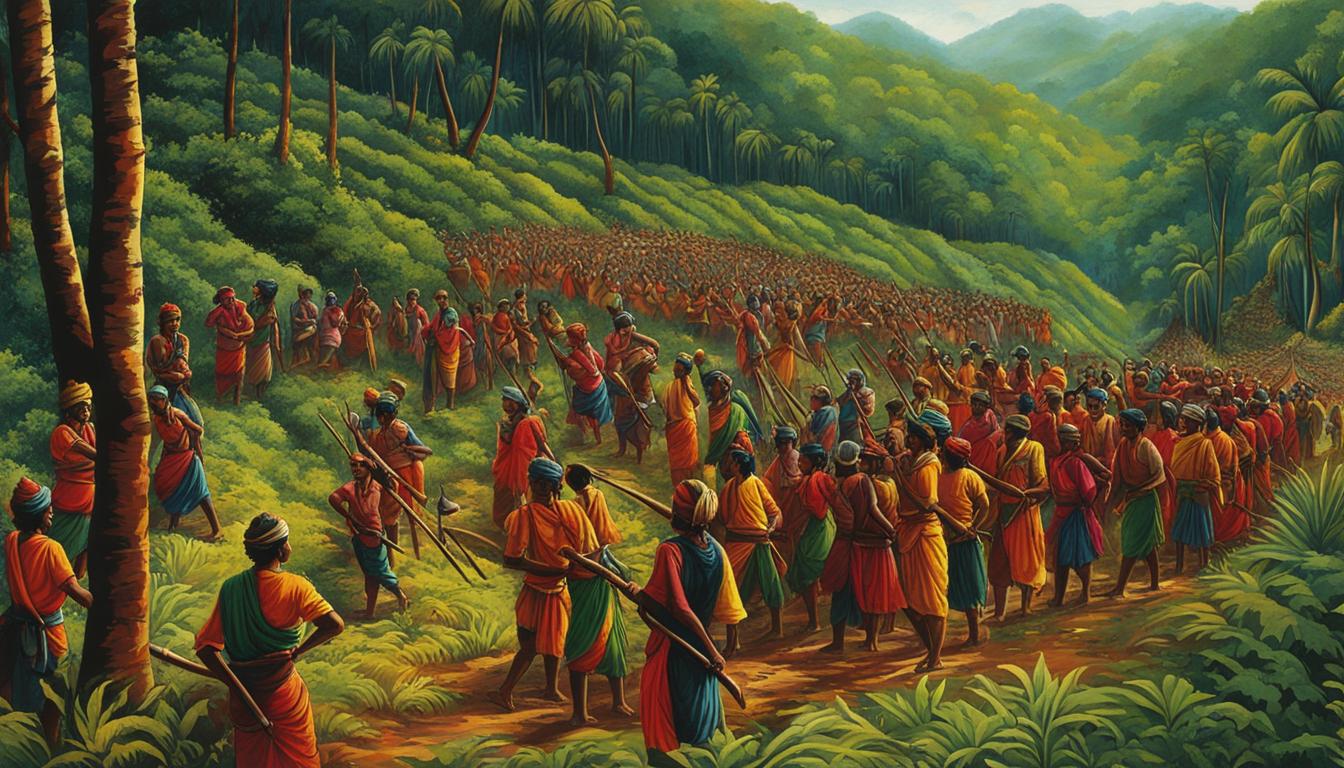The Kurichya Revolt of 1812 holds immense historical significance in Indian history. It sheds light on the bravery and resilience of the Kurichya tribe, who rebelled against the oppressive British rule in Wayanad, Kerala.
The revolt, led by notable leaders like Rama Nambi, was a response to unjust policies imposed by the British administration. These policies included the introduction of cash payments for taxes and the confiscation of land, which caused immense hardships for the Kurichya people.
The Kurichya tribe, known for their skills as agriculturalists, rose up against these injustices, uniting with other tribal communities in Wayanad. Though the revolt was ultimately suppressed by the British, it remains a testament to the indomitable spirit of the Kurichya warriors and their fight against colonial exploitation.
Key Takeaways:
- The Kurichya Revolt was a significant event in Indian history, showcasing the bravery of the Kurichya tribe.
- It was a response to oppressive British policies, including cash payments for taxes and land confiscation.
- Led by leaders like Rama Nambi, the revolt spread across Wayanad with support from other tribal communities.
- Although suppressed, the revolt remains a symbol of courage and resilience in the fight against colonial exploitation.
- The Kurichya Revolt continues to inspire future generations and is an integral part of Kerala’s historical narrative.
Origin and Causes of the Kurichya Revolt
The Kurichya Revolt of 1812 was a response to the oppressive policies implemented by the British colonial administration in Wayanad. The Kurichya tribe, agriculturalists in the region, faced severe hardships due to these policies, which ultimately led to their rebellion against British rule.
One of the key factors that fueled the revolt was the introduction of a new revenue settlement by the British authorities. Under this settlement, the Kurichya tribe was forced to make cash payments instead of the traditional forms of payment they were accustomed to. This change in the revenue system created financial burdens and increased the economic strain on the Kurichya people.
In addition to the new payment system, the British colonial administration also initiated land confiscation measures. Those who could not meet the new tax requirements faced the seizure of their land and property. These unjust policies further contributed to the discontent and frustrations among the Kurichya tribe, strengthening their resolve to resist the British.
Furthermore, the broader dissatisfaction with British rule played a significant role in the Kurichya tribe’s decision to revolt. The oppressive taxation and land confiscation policies were just one aspect of the unjust colonial administration they had to endure. These policies, coupled with a growing awareness of their rights and a desire for freedom, led to a collective sense of discontent and the determination to fight for justice.
“The Kurichya Revolt was a natural consequence of the British government’s oppressive policies that targeted the tribal communities. Our people have been subjected to unfair treatment for far too long, and it was time to rise against these injustices.” – Rama Nambi

The Kurichya Revolt, with its origins in the oppressive British policies of cash payments and land confiscation, exemplified the resistance of the Kurichya tribe against colonial exploitation. The subsequent sections will delve into the course of the revolt and its suppression, providing a comprehensive understanding of this crucial period in Kerala’s history.
Course and Suppression of the Kurichya Revolt
In March 1812, the brave Kurichya tribe, led by Rama Nambi, took up arms and initiated the kurichya revolt against the oppressive British forces. Supported by the Kurumbar tribe, the rebellion quickly spread like wildfire across the region of Wayanad in Kerala, India.
The revolt witnessed a significant turning point when the Kurichya Kolkars, who were tribal police serving the British administration, defected and joined the rebel forces. This defection intensified the revolt and added strength to the kurichya tribe’s resistance.
With the rebel forces growing in number and determination, they strategically gained control of crucial passes, disrupting British operations and launching daring attacks on police stations. The British flag ceased to fly over Wayanad for a brief period as the revolt held sway, empowering the kurichya tribe and inspiring hope among other communities.

For a short time, the kurichya revolt challenged the might of the British forces and shook the foundations of their authority in Wayanad. The kurichya tribe’s remarkable courage and resilience became a symbol of defiance against colonial exploitation.
However, the British government was determined to suppress the rebellion and restore control. Marshaling their forces, the British launched a fierce campaign against the kurichya tribe. Despite the valiant efforts of Rama Nambi and his fellow kurichya warriors, the revolt was ultimately suppressed by the overwhelming British military power.
This tragic turn of events marked the demise of Rama Nambi, a revered leader who had played a crucial role in organizing and leading the rebellion. While the kurichya revolt may have been silenced, its impact and historical significance remain ingrained in the collective memory of Kerala’s tribal communities.
Conclusion
The Kurichya Revolt holds significant historical importance in Kerala’s narrative, serving as a testament to the courage and resilience of its tribal communities. This uprising exemplifies their unwavering determination in the fight for justice and freedom against oppressive colonial rule. Despite being suppressed, the revolt’s historical significance as a symbol of resistance remains deeply ingrained in the collective memory of Kerala.
The Kurichya Revolt galvanized future generations, inspiring them to continue the struggle against colonial exploitation. Today, it stands as a powerful reminder of the sacrifices made by the tribal communities in their fight for independence and land rights. The revolt’s impact resonates even today, amplifying the voices of marginalized communities and inciting conversations about social justice.
Kerala’s tribal communities, including the Kurichya tribe, embody the indomitable spirit that defined the revolt. Their resilience and perseverance continue to shape the cultural tapestry of the region, reminding us of the strength found in unity and the endurance required to overcome adversity. The kurichya revolt will forever be recognized as a significant chapter in Kerala’s history, depicting the unwavering spirit of its tribal communities in their pursuit of justice and equality.
FAQ
What was the Kurichya Revolt?
The Kurichya Revolt of 1812 was a significant event in Kerala’s history where the Kurichya tribe, agriculturalists in Wayanad, rebelled against British rule in response to oppressive policies.
Who led the Kurichya Revolt?
The revolt was led by notable leaders like Rama Nambi, who played a crucial role in organizing and mobilizing the Kurichya tribe.
What were the causes of the Kurichya Revolt?
The revolt had its roots in the oppressive policies of the British colonial administration, including the introduction of cash payments for taxes and the confiscation of land.
How did the Kurichya Revolt spread?
The revolt spread across Wayanad, with support from other tribal communities, and gained control of strategic passes, disrupted British operations, and launched attacks on police stations.
How was the Kurichya Revolt suppressed?
The revolt was ultimately suppressed by the British government marshaling its forces and led to the tragic demise of Rama Nambi.
What is the historical significance of the Kurichya Revolt?
The Kurichya Revolt symbolizes courage and resilience in Kerala’s history, showcasing the determination of tribal communities in their struggle for justice and freedom against colonial exploitation.

